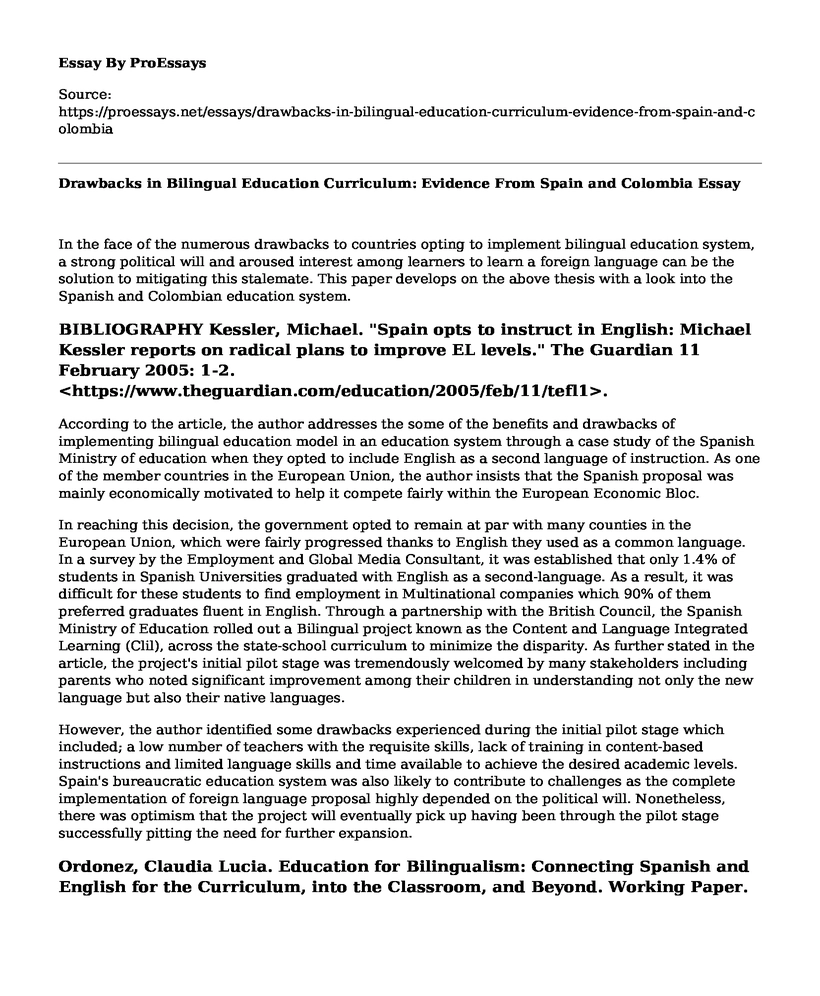In the face of the numerous drawbacks to countries opting to implement bilingual education system, a strong political will and aroused interest among learners to learn a foreign language can be the solution to mitigating this stalemate. This paper develops on the above thesis with a look into the Spanish and Colombian education system.
BIBLIOGRAPHY Kessler, Michael. "Spain opts to instruct in English: Michael Kessler reports on radical plans to improve EL levels." The Guardian 11 February 2005: 1-2. <https://www.theguardian.com/education/2005/feb/11/tefl1>.
According to the article, the author addresses the some of the benefits and drawbacks of implementing bilingual education model in an education system through a case study of the Spanish Ministry of education when they opted to include English as a second language of instruction. As one of the member countries in the European Union, the author insists that the Spanish proposal was mainly economically motivated to help it compete fairly within the European Economic Bloc.
In reaching this decision, the government opted to remain at par with many counties in the European Union, which were fairly progressed thanks to English they used as a common language. In a survey by the Employment and Global Media Consultant, it was established that only 1.4% of students in Spanish Universities graduated with English as a second-language. As a result, it was difficult for these students to find employment in Multinational companies which 90% of them preferred graduates fluent in English. Through a partnership with the British Council, the Spanish Ministry of Education rolled out a Bilingual project known as the Content and Language Integrated Learning (Clil), across the state-school curriculum to minimize the disparity. As further stated in the article, the project's initial pilot stage was tremendously welcomed by many stakeholders including parents who noted significant improvement among their children in understanding not only the new language but also their native languages.
However, the author identified some drawbacks experienced during the initial pilot stage which included; a low number of teachers with the requisite skills, lack of training in content-based instructions and limited language skills and time available to achieve the desired academic levels. Spain's bureaucratic education system was also likely to contribute to challenges as the complete implementation of foreign language proposal highly depended on the political will. Nonetheless, there was optimism that the project will eventually pick up having been through the pilot stage successfully pitting the need for further expansion.
Ordonez, Claudia Lucia. Education for Bilingualism: Connecting Spanish and English for the Curriculum, into the Classroom, and Beyond. Working Paper. Bogota: Universidad Nacional de Colombia, 2011. <https://files.eric.ed.gov/fulltext/EJ1051536.pdf>.
On the same subject, Claudio conducted a qualitative study in Colombia to determine the impact of Bilingual Education curriculum on the authentic communicative performance for a society that is mostly monolingual in Spanish. In such a context, he established that it was always difficult to motivate children to learn the foreign language given the little interaction with English. For instance, it is seldom to find people talking in English leave alone books written in many Big Cities of Colombia. More so, the case is almost unperceivable in the rural areas. Still, there were few private schools that were teaching the curriculum.
Still, the author believed the trend could be changed if the Bilingual Education could be perceived differently. He came up with the notion of "Education for Bilingualism," developed under the premise that anyone could learn a new language depending on the need and wish to use the language. To prove his theory, he conducted a study to determine what would motivate Colombians to learn English. In most of the responses obtained, social need and pragmatic demands for communications acted as overriding factors for many to learn a new language.
Based on these results, Claudio came to the deduction that education for bilingualism revealed positive changes with regard to language learning environment. For that matter, he went further to make a personal statement that education for bilingualism should replace the Bilingual curriculum in fostering the learning of English. In personal opinion, I believe this proposal might fail unless a public interest to learn English is created among the Colombians who are predominantly a Spanish-speaking group.
Works Cited
Kessler, Michael. "Spain opts to instruct in English: Michael Kessler reports on radical plans to improve EL levels." The Guardian 11 February 2005: 1-2. <https://www.theguardian.com/education/2005/feb/11/tefl1>.
Ordonez, Claudia Lucia. Education for Bilingualism: Connecting Spanish and English for the Curriculum, into the Classroom, and Beyond. Working paper. Bogota: Universidad Nacional de Colombia, 2011. Print. <https://files.eric.ed.gov/fulltext/EJ1051536.pdf>.
Cite this page
Drawbacks in Bilingual Education Curriculum: Evidence From Spain and Colombia. (2022, Jun 19). Retrieved from https://proessays.net/essays/drawbacks-in-bilingual-education-curriculum-evidence-from-spain-and-colombia
If you are the original author of this essay and no longer wish to have it published on the ProEssays website, please click below to request its removal:
- Report of School: St. John's University
- Essay on Children Education in Homeless Families
- Online Learning as a More Effective Tool in Distance Learning Essay Example
- Research Proposal on Issues with Education: Standardized Testing and Class Sizes
- Essay Example on Cognitive Development: Piaget's Stages of Growth in Children
- Paper Sample: Fresh Graduate Aims for Renewable Energy Master's Degree
- Free Paper Sample: My Life Development from Childhood







